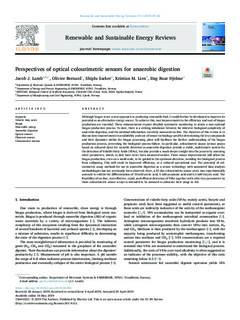| dc.contributor.author | Lamb, Jacob Joseph | |
| dc.contributor.author | Bernard, Olivier | |
| dc.contributor.author | Sarker, Shiplu | |
| dc.contributor.author | Lien, Kristian Myklebust | |
| dc.contributor.author | Hjelme, Dag Roar | |
| dc.date.accessioned | 2019-11-29T07:56:44Z | |
| dc.date.available | 2019-11-29T07:56:44Z | |
| dc.date.created | 2019-05-21T12:19:46Z | |
| dc.date.issued | 2019 | |
| dc.identifier.citation | Renewable & Sustainable Energy Reviews. 2019, 111 87-96. | nb_NO |
| dc.identifier.issn | 1364-0321 | |
| dc.identifier.uri | http://hdl.handle.net/11250/2630963 | |
| dc.description.abstract | Although biogas is not a new approach to producing renewable fuel, it could further be developed to improve its potential as an alternative energy source. To achieve this, vast improvements in the efficiency and cost of biogas production are essential. These enhancements require detailed systematic monitoring to attain a near-optimal biogas production process. To date, there is a striking imbalance between the inherent biological complexity of anaerobic digestion, and the minimal information currently measured on-line. The objective of this review is to discuss how improvements in availability and cost of sensor technology used for determining the key compounds and their dynamics within the biogas processing plant will facilitate the further understanding of the biogas production process, preventing the biological process failure. In particular, colourimetric assays (sensor assays based on coloured dyes) for variable detection in anaerobic digestion provide a stable, multivariate system for the detection of Volatile Fatty Acids (VFAs), but also provide a much deeper insight into the process by assessing other parameters, which, to date have never been measured on-line. These sensor improvements will allow the biogas production, even on a small scale, to be guided in the optimum direction, avoiding the biological process from collapsing. This will result in improved efficiency, at a reduced operational cost. The potential of colourimetric assay methods for use in anaerobic digestion as a sensor technology with associated data analysis methodologies has not previously been observed. Here, a 23-dye colourimetric sensor array was experimentally assessed to exhibit the differentiation of 10 mM acetic acid, 5 mM propionic acid and 0.3 mM butyric acid. The feasibility of on-line, cost-effective, rapid, and efficient detection of VFAs together with other key parameters by these colourimetric sensor arrays is intended to be assessed to advocate their usage in AD. | nb_NO |
| dc.language.iso | eng | nb_NO |
| dc.publisher | Elsevier | nb_NO |
| dc.rights | Navngivelse 4.0 Internasjonal | * |
| dc.rights.uri | http://creativecommons.org/licenses/by/4.0/deed.no | * |
| dc.title | Perspectives of optical colourimetric sensors for anaerobic digestion | nb_NO |
| dc.type | Journal article | nb_NO |
| dc.type | Peer reviewed | nb_NO |
| dc.description.version | publishedVersion | nb_NO |
| dc.source.pagenumber | 87-96 | nb_NO |
| dc.source.volume | 111 | nb_NO |
| dc.source.journal | Renewable & Sustainable Energy Reviews | nb_NO |
| dc.identifier.doi | 10.1016/j.rser.2019.04.083 | |
| dc.identifier.cristin | 1699074 | |
| dc.description.localcode | This is an open access article distributed under the terms of the Creative Commons CC-BY license, which permits unrestricted use, distribution, and reproduction in any medium, provided the original work is properly cited. You are not required to obtain permission to reuse this article. | nb_NO |
| cristin.unitcode | 194,63,35,0 | |
| cristin.unitcode | 194,64,25,0 | |
| cristin.unitcode | 194,64,94,0 | |
| cristin.unitname | Institutt for elektroniske systemer | |
| cristin.unitname | Institutt for energi- og prosessteknikk | |
| cristin.unitname | Institutt for vareproduksjon og byggteknikk | |
| cristin.ispublished | true | |
| cristin.fulltext | original | |
| cristin.qualitycode | 1 | |

